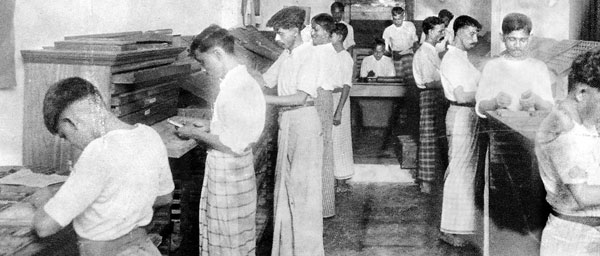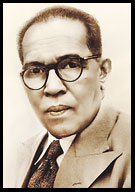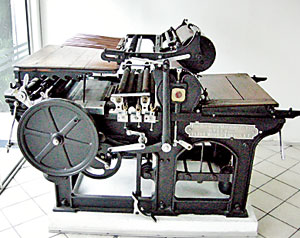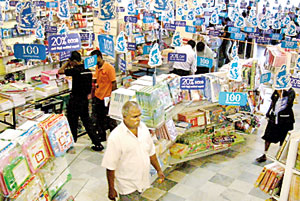An indelible imprint
View(s):Long years ago a young boy, Malagalage Don Gunasena’s fascination with the many presses on Dam Street soon turned into a vision and today M.D. Gunasena & Company, a pioneer in publishing and printing celebrates 100 years. Kumudini Hettiarachchi rolls back the years as the company marches on
It was a must-visit for most parents every year, who with their children in tow, clutching long book lists would throng this landmark building, amidst the hurly-burly of the Pettah. For many of those who were students before the educational authorities decided to issue free textbooks, it would be ‘first to Gunasenas and then to school’.
By that time M.D. Gunasena & Company was a giant in the arena of book publishing and printing, a privilege it holds even today, 100 years after it was founded.
Humble though the beginnings of this book printing empire were, its Founder’s vision and values are what has steered it through many a turbulent time.

Back in time: The work at the printing press
As his eldest son, Sepala, was once to recount it was as a mere boy that Malagalage Don Gunasena peered in fascination through the windows as the rolling wheels of the huge Wharfdale machines, moved to and fro in their tracks, to churn out sheets of printed matter at the many presses on Dam Street. These printed sheets bound together would eventually end up as books.
He was still a schoolboy at Wesley College then also on Dam Street but the attraction of the machines was so great that he would run errands for the printers just to be able to get a closer look at them. Gunasena had been packed off to Wesley College by his father Malagalage Don Carolis Peiris Appuhamy and mother Galpotte Kankanamalage Sophaya Perera Hamine, a paddy farming family of Wewala, Salpiti Korale. The youngest son in a family of three, although his education began at the Wewala Government School, his horoscope indicated that he would attain greatness. So it was that his parents sent him to Wesley College to get acquainted with the language of the rulers then, which was English.
Soon, however, the family fortunes changed and they just could not afford the luxury of giving him an English education. He was compelled after Standard 4 to take up the rudiments of Sinhala medicine with a Veda Mahattaya in Grandpass. But destiny decreed otherwise.
Seeing Gunasena labouring over the study of ancient Pali and Sanskrit slokas, his elder brother who had a small grocery in Colombo suggested that he learn a trade. It was then that Gunasena, following his boyhood fascination, requested that he be sent to the Boys’ Industrial Home attached to the Wesley Press.
Qualifying as a printer, there was no turning back and Gunasena joined H.S. Perera to help in the printing of the ‘Dinamina’ at the Lanka Abhihawa Visrutha Press of Pundit Robert Batuwanthudawa which would later go to his son-in-law Sir Baron Jayatilaka. While involved in setting up type and printing the ‘Dinamina’, a bout of illness forced Gunasena to go back home to Wewala.
On his return to Colombo he sought an opening at the Government Press with a letter of introduction from Pundit Thomas Karunaratne, only to be told that Government Printer Cotton had left for England on furlough. With no job, he was at his boarding on Green Street when a friend told him about a vacancy for a compositor at Sir Harry Van Cuylenberg’s ‘Independent’ newspaper at Hulftsdorp, which he took up. It was here that he earned his first salary. Ironically, 30 years later he would be offered the premises on sale which he would buy without hesitation. It would later become home to Independent Newspapers Ltd., an associate company of M.D. Gunasenas, which shut down in 1990.
Gunasena’s adventurous spirit, however, did not allow him to hold down this job for long and he took up the post of manager at Wijewickremage John Appuhamy’s Victor Press on Dias Place near Price Park. Many were the roles he played as salesman, canvasser, bill collector, designer and printer, visiting establishments to obtain orders and collecting dues from customers. Confronted by Appuhamy around 10 one morning whether that was the time he was coming to work, when he had been walking all over the Fort in search of print orders, he had taken umbrage, dumped all the orders, monies collected and keys to his desk and walked out. A week later when Appuhamy apologised and asked him to return, he refused, vowing “never again to work under anybody”.

The man who started it all: M.D. Gunasena
Appuhamy then proposed that he buy Victor Press but when he declined as he didn’t have the money, the owner suggested that he run the press on a monthly rental payment. That was the defining moment in Gunasena’s life – way back in 1913, a century ago.
With determination complemented by hard work, progress and success came quickly thereafter……..buying a second-hand printing machine from N.S. Fernando & Company and installing it at premises in Kotahena; buying the plant and machinery of the Victor Press itself and taking those to Kotahena and naming his business New Victor Press; moving to larger premises on First Cross Street, Pettah in 1917; and relocating two years later at No. 12, Fifth Cross Street.
Here he seized on the great demand for shokaprakasha pamphlets about deaths and also the qualities of the dead person. On receiving hospital telegrams, the relatives of the bereaved would travel to Colombo by the evening bus. With the outstation bus-stop being between Fifth Cross Street and Gas Works Street, the New Victor Press was well-placed to take these one-off orders, the turnover of which as well as the margins was high.
By this time 29-year-old Gunasena was also on the threshold of a new life, having married 17-year-old Lilian Senehelatha Perera from Grand Pass on November 30, 1922.
As the press expanded, he borrowed more funds from the Chettiars of Sea Street to meet working expenses, as banks did not lend to small-time Sinhala businessmen. When the Japanese paper supplier, Kiichi Ensha, whom Gunasena took on as a partner in 1919, expressed concern over his debts in 1925, he cancelled the partnership, paying him in full.
Now the business was his alone and a name-change to M.D. Gunasena & Company followed, while also renting out No. 10, Fifth Cross Street to accommodate more machinery and staff. That year saw the company getting into book publishing, with sales and distribution being handled by booksellers K.D. Perera & Sons, J.D. Fernando & Company and W.E. Bastian & Company. Acquiring lock, stock and barrel, the small firm of book publishers, C. Boteju & Co of 32, Dam Street, the company came into possession of stocks and copyrights in 1926.
With more space being needed as the business expanded rapidly in 1929, the Gunasena Company moved to No. 217 & 219, Norris Road (Olcott Mawatha), its current headquarters, with another road frontage on Maliban Street. While the bookshop and retail stationery business was conducted from Olcott Mawatha, printing was carried out in the middle section and the wholesale business from Maliban Street. At this time the company was at the forefront of publishing books on ayurveda, Buddhist texts in Sinhala and Pali and Sinhala classics and novels by well-known authors……famous Martin Wickremasinghe; Prof. Gunapala Malalasekera of English-Sinhala Dictionary fame; V.D. de Lanerolle, a name synonymous with children’s books; Dr. E.W. Adikaram who was a pioneer in popularising science among Sinhala readers; and Munidasa Kumaratunga “who used his pen as a weapon to evoke nationalist feeling among the young”.
With M.D. Sirisena, a nephew of Gunasena joining the company in 1932, it was taken to a different height. The same year the company began providing a different kind of service — cashing the salary cheques of teachers who came from across the country on Saturday to pick up their cheques from the managers of the various assisted schools as well as the government Education Department. Otherwise they would be fleeced by moneychangers. And it was here that not only teachers but also many writers rendezvoused, debating on literary matters, while leaning against the bookshelves.
More changes came about with an import department being set up in 1939 and further premises being purchased from Helena Jayewardene (nee Wijewardene), mother of J.R. Jayewardene in 1943. The transformation from a proprietary business to a limited liability company was in 1945, with that all-too-familiar logo of Gurulugomi, the 12th century author of Amavatura and Dharmapradipika, adorning every single Gunasena book since 1949. Created by reputed artist G.S. Fernando, this symbol of “quality literature” was first used in Martin Wickremasinghe’s ‘Sahityodaya Katha’ published in 1949.
By 1959, the company was publishing almost 300 titles a year, virtually a book a day. When the Olcott Mawatha building was put up it was one of the two largest purpose-built bookshops in the world, the other being in Helsinki built a year earlier.
For Nanda Jayaweera, 73, it was like yesterday when she joined the company back in 1962 as a slip of a girl. Those were the days when hand composing was in vogue, she smiles, adding that at the test she had to type a letter that was dictated to her. “I think I made two mistakes, but I was told to go have my lunch and come back to take up work as a Sinhala stenographer.”
The authors of the time used to handwrite their work on foolscaps and the balance work was done at Gunasenas – counting the words, estimating the number of lines, size of the book etc, hand composing it et al. There have been no regrets for Nanda. Fifty-three years on, she believes that the vibrancy and dynamism of the company still live on.
A little piece of history
It has pride of place at M.D. Gunasena Printers at Hulftsdorp – the first letter press that M.D. Gunasena built his business on. But it is the first offset litho machine that he bought that made history in Sri Lanka. World War II was over and the Southeast Asia Command under Lord Louis Mountbatten headquartered at Peradeniya invited bids for the sale of the litho plant set up at Kundasale for map-printing to feed the various theatres of war.

Pride of place: The letter press
The response from local printers was poor as photo offset lithography was unchartered territory. But Gunasena did go and being impressed with the British Officer-in-Charge of the plant, J.A. Witchell, an alumni of the London School of Printing who was an expert in every aspect such as camera, re-touching, plate making and machinery repair and maintenance invited him to join him after demobilisation.
Although the sale of the printing plant was withdrawn as it had been requisitioned by the British Indian Army for its map printing installation at Dehradun, Sepala, Gunasena’s eldest son, was sent to Britian to buy similar machinery.
With only Messrs. R.W. Crabtree and Messrs R. Mann manufacturing these machines there was a long waiting list. No Double Demy size machine (22˝”X35”) was available only a Quad Crown machine (30”X40”), that too very much in demand, which Gunasenas snapped up.
When in 1947, the British Royal Navy vacated No. 20, San Sebastian Hill, the premises of Gunasenas at Hulftsdorp, the printing machines were moved from the Norris Road premises. It was then that the company was split into two – M.D. Gunasena & Co Ltd., as publishers, booksellers and stationers and M.D. Gunasena & Co. (Printers) Ltd., for the printing.
The first job of the newly-installed machine was the Gunasena Almanac for 1948, making them the pioneers in offset lithography.
Moving with the times
What lies ahead for M.D. Gunasena & Company? Further expansion in keeping with modern trends and technology, while fiercely safeguarding and espousing the five core values of the Founder is what his children and grandchildren are hoping to achieve with the legacy left by M.D. Gunasena who died on May 19, 1959 at the not-so-old age of 66. Those values are love, integrity, responsibility, humility and above all gratitude, they say.

Today: The headquarters on Olcott Mawatha. Pic by Athula Devapriya
A Book Hub in partnership with Etisalat and Microimage, for e-mail publication has already been launched. This is the only one in Sri Lanka where authors may send their works and Gunasenas will convert it into e-format and also sell them on its website. These books in e-format can be read on a computer as well as a smart phone, says current Chairman and Founder’s son, Percy Gunasena.
The Deputy Managing Director and grandson Rajiv Gunasena says soon people in Australia and Canada would be able to download Sinhala books at the click of a mouse. If we don’t embrace new technology we will suffer the same fate as the well-known bookstore Borders. It is a “do or die” situation. Like Barnes and Noble, a traditional bookshop now catering to modern times, Gunasenas are set to go along a similar path.
Our website is being revamped and would soon be linked to the logistics component for door-to-door delivery. Even if international customers give a list, the orders will be shipped out. We are also tying up with large Indian book distributors with links to their websites. Acting as a source, without in fact storing the books on our shelves, Gunasenas will route those books as a one-stop shop. This would become a reality in about three months. Another is the launching of a Loyalty Card, a first in the industry, he says. Diversifying into education of a different kind, Gunasenas have set up a school at Hulftsdorp, now 12 years old, to give an English education while moulding students with a strong grounding in Sri Lankan values and culture.
Amidst all this, Gunasenas have not forgotten that they “taught the nation to read”. In these challenging times when the distractions from books are numerous, refurbishment into state-of-the-art yet cosy bookshops is underway, for young and old not only to come buy a book but also pick up a book, browse through it undisturbed, put it down and pick up another.
One hundred new titles to match their centenary anniversary is their hope for this year.
Follow @timesonlinelk
comments powered by Disqus



















